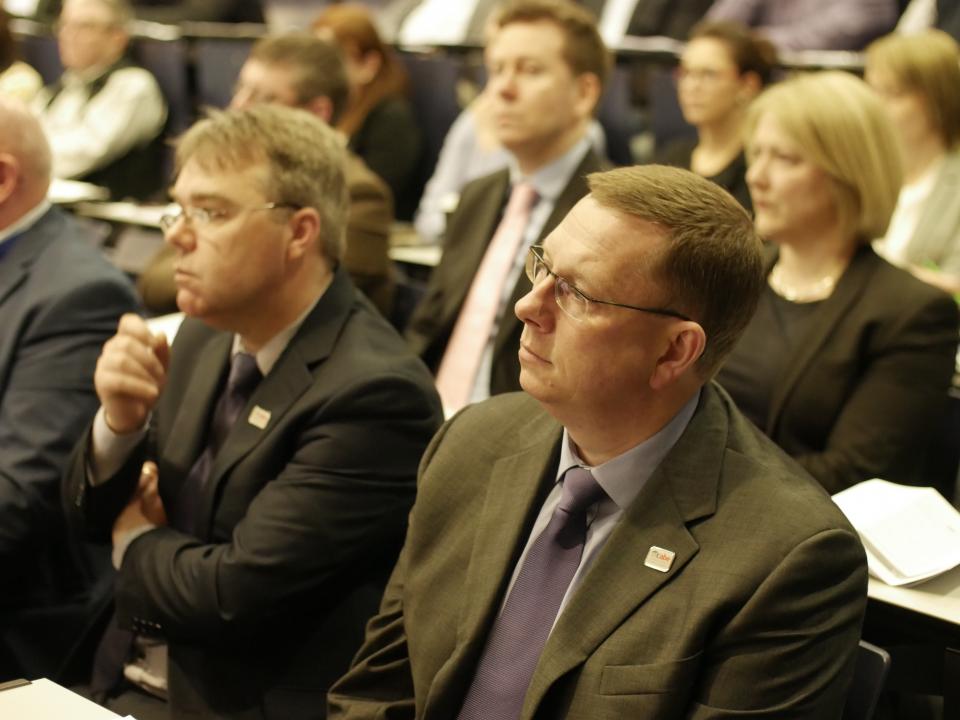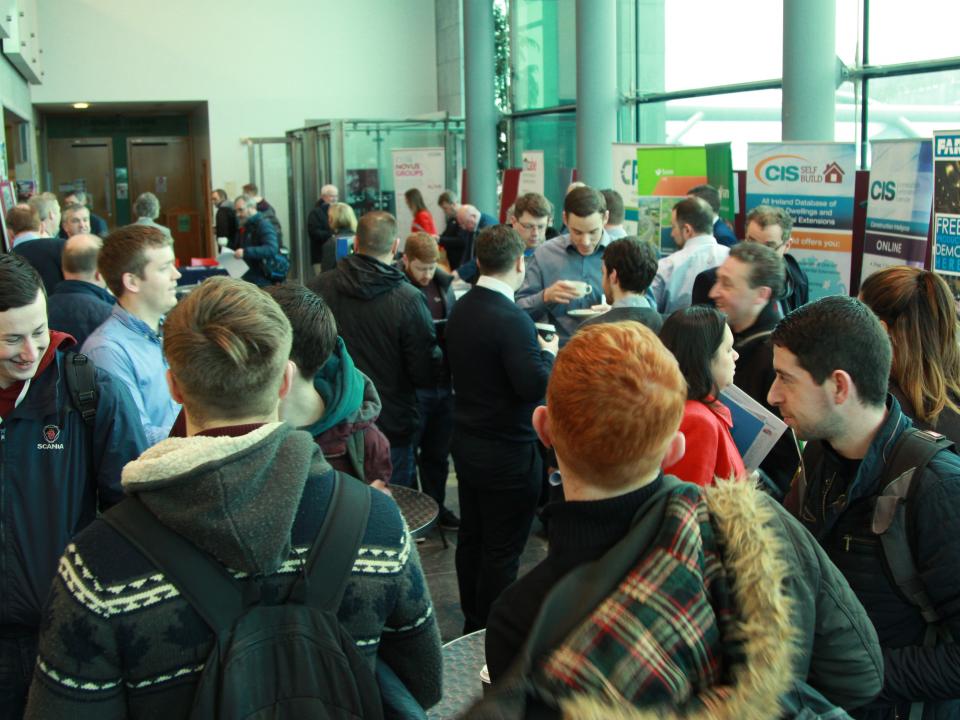GMIT 7th Annual International Construction Management Day hears of positive outlook for the construction sector - 20% Growth Forecast for 2017
The 7th Annual GMIT International Construction Management Day Conference was held at the GMIT Dublin Road campus on Tuesday 7th March, hosted by the Department of Building and Civil Engineering. GMIT President, Dr Fergal Barry, opened proceedings by welcoming over 350 delegates to the conference. Dr Barry outlined GMIT plans for capital development of the Institute, in particular noting the urgent need for a new Science, Technology, Engineering and Maths (STEM) Building. Dr Barry also welcomed the large increase in first year students into the Department of Building and Civil Engineering and the significant student support and measures that have been put in place.
We in GMIT are delighted at the growing success of the annual conference which started in 2011 in very challenging times for the industry. We have received great support from industry practitioners including contractors, architects, engineers and surveyors which has helped the conference go from strength to strength.
A very positive morning session took place where the keynote address was given by Minister of State of the Office of Public Works and Flood Relief, Seán Canney, TD, a graduate and lecturer of GMIT. Minister Canney was joined in the session by Mr John O’Regan, Director of AECOM Ireland and Mr Tom Parlon, Director General of the Construction Industry Federation. All three speakers noted the very positive outlook for construction as delegates heard that construction output in Ireland had increased by 15% in 2016 and was forecast to increase by 20% in 2007. Both Minister Canney and John O’Regan stated that a very significant issue was the unbalanced nature of this growth, which is very heavily concentrated in the eastern side of the country. The western side, whilst growing, was recovering at a far slower rate. The Minister said that this was a matter which concerned him greatly and welcomed the announcement of the Government – Ireland 2040 plan, which is a national planning framework, with the intention to a provide more broadly spread development. Tom Parlon congratulated GMIT final year students who were in attendance. Tom said they had been very brave to sign up to building related programmes in 2013, but are now reaping the opportunities of multiple and well paid job offers. The panel also noted the upcoming World Women’s Day, discussing several initiatives to encourage greater diversity in the industry.
A number of parallel breakout sessions were held in the pre-lunch sessions. A major focus was given to Building Information Modelling (BIM) whereby highly accurate 3D models of construction projects can be used to model out design errors before they arrive on site. The BIM models also facilitate accurate costing and time programming of projects. Virtual Reality (VR) headsets can then be used to allow designers, contractors or end-users to ‘go inside’ the model and see what it would look like before it is constructed. 100 VR headsets were given out to delegates so that they could immerse themselves in the BIM models on display.
Ralph Montague, Managing Partner of ArcDox, considered the current inefficiencies of construction and outlined the potential of BIM to improve efficiency and engender a ‘right first time’ approach. Cillian Kelly, National BIM Leader from John Sisk and Son Contractors, demonstrated BIM from a time programming perspective, whilst Aonghus Callanan, Director of TC Estimating Services, explored the cost estimating potential of BIM. The Session was rounded off by Jan Gottsche, representing BAM Contractors and Dr Mark Kelly of GMIT, who have been working on research projects in the area of sustainability. They considered how the sustainability agenda can be advanced in construction, making use of tools such as BIM. Head of the Department of Building and Civil Engineering, Mary Rogers, said she was delighted with the success of the conference. Mary said “The attendance here today is phenomenal and demonstrates the close connection between our department and the industry it serves”. Mary added “I am pleased that GMIT has led the way in the introduction and use of BIM in the west of Ireland. Last year we also introduced a BIM Level 8 Diploma, specifically designed to meet the upskilling needs of industry for BIM”.
Mr Martin Meehan, principal of Meehan Associates, gave a very informative presentation entitled ‘From sow’s lug to silk purse’ This charted the redevelopment of Block B, East Point Business Park in Dublin to a LEED Platinum standard. This is an exceptionally high quality in terms of sustainability and bodes well for the redevelopment of the remainder of the complex. The project and Meehan Associates have received several distinguished awards for the project. Pat McGrath, Head of Research and Systems Development at Construction Information Services, presented on the use of data mining to inform construction development decisions. CIS pull together a vast range of historical and new data to identify development needs in a strategic way. Pat demonstrated the needs for student housing, by using GPS mapping. The final speaker before lunch was Enda McGuane, Managing Director of Winters Property Management. Enda took up the baton regarding the shortage of student housing in Galway and Ireland and considered the economics and design characteristics of encouraging development of much needed additional spaces. Enda noted that to be commercially cost effective, purpose built student residences needed a minimum of 100 bed spaces.
The afternoon session took on a distinctly international perspective, with the majority of speakers coming from the UK. Mr Ben Bradford, President of the Chartered Association of Building Engineers (CABE), is an internationally known expert in fire safety management. He joined the conference from the UK and gave a very entertaining presentation of innovation and the evolving nature of fire safety management. Ben stated that this is an area of building regulation compliance that is often badly neglected, noting high profile issues with major projects in both Ireland and the UK. Whilst he was in attendance, Ben also presented CABE academic accreditation for GMIT programmes in Construction Management, Quantity Surveying and Construction Economics, Civil Engineering and Architectural Technology. The awards were received on behalf of GMIT by Mr Michael Hannon, Vice-President for Academic Affairs and Registrar. Michael said he was delighted to receive these accreditations on behalf of GMIT and looked forward to a long lasting partnership with CABE that should endeavour to improve the quality of our programmes.
The next speaker was also from the UK, Mr Chris Chivers, who is the Immediate Past President of the Chartered Institute of Building (CIOB). Chris gave a lively personal view of BREXIT, concluding, in a balanced way, that the whole process to date had been very confusing, both to him and many others in the UK. Claims made by both sides of the argument were very subjective and in almost all cases lacked any conclusive proof. Chris also noted that the BREXIT vote was currently having a very limited impact on UK construction, which continued to expand, helped by the fact that 25% of all construction workers in the south of England were in fact EU nationals. He concluded by advising that as “all of the facts are not on the table” it is thus very difficult to make any credible claims at this stage for the end result.
The final speaker of the day was Mr Pauric Marray, Director of Quigg Golden, who are specialists in construction procurement and law. Pauric reviewed recent changes to the Public Works contracts, which are mandatory for use on public works, since 2007. Following their introduction, many in the construction industry felt they were unfair in the way they apportioned risk to contractors. A significant review of the contracts has been taking place and Pauric outlined the technical changes that have been made in the interest of achieving a fairer and more cost effective outcome.
Mr Gerard MacMichael, Head of the School of Engineering at GMIT closed proceedings by thanking delegates for their great support for the conference and hoped they had enjoyed their day. The conference is provided Free of charge by kind support of sponsors, The Chartered Institute of Building; The Chartered Association of Building Engineers; and Society of Chartered Surveyors Ireland and AEDIS, who provide a range of complementary construction solutions in the building control, structural warranties and health and safety areas.


